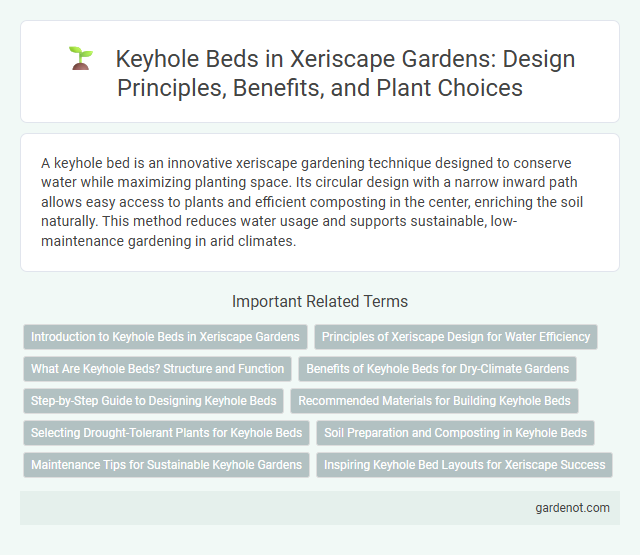A keyhole bed is an innovative xeriscape gardening technique designed to conserve water while maximizing planting space. Its circular design with a narrow inward path allows easy access to plants and efficient composting in the center, enriching the soil naturally. This method reduces water usage and supports sustainable, low-maintenance gardening in arid climates.
Introduction to Keyhole Beds in Xeriscape Gardens
Keyhole beds are circular garden beds featuring a narrow entrance path leading to a central composting basket, designed to conserve water and enrich soil in xeriscape gardens. This efficient design maximizes moisture retention and nutrient recycling, reducing irrigation needs and promoting sustainable planting. Popular in drought-prone areas, keyhole beds support drought-tolerant plants by creating microclimates essential for xeriscape success.
Principles of Xeriscape Design for Water Efficiency
Keyhole beds maximize water efficiency by concentrating irrigation at the center, reducing runoff and evaporation, and allowing roots to access moisture evenly. Incorporating native drought-tolerant plants with proper soil amendments enhances water retention and minimizes irrigation needs. This design aligns with xeriscape principles by optimizing water use, promoting sustainable landscaping, and conserving natural resources.
What Are Keyhole Beds? Structure and Function
Keyhole beds are a type of xeriscape garden design featuring a circular or rounded bed with a narrow inward path resembling a keyhole shape. The central area often includes a compost basket for organic matter, which enriches the surrounding soil as it decomposes, promoting efficient water retention and nutrient cycling. This structure maximizes space, reduces water consumption, and supports sustainable gardening practices in arid environments.
Benefits of Keyhole Beds for Dry-Climate Gardens
Keyhole beds maximize water efficiency by directing moisture to a central composting basket, significantly reducing irrigation needs in dry-climate gardens. Their circular design promotes nutrient-rich soil, which enhances plant growth and conserves water in arid conditions. This sustainable gardening technique supports drought-resistant plants by maintaining optimal hydration levels with minimal water use.
Step-by-Step Guide to Designing Keyhole Beds
Designing keyhole beds begins by selecting a circular or square planting area with a narrow wedge-shaped indentation for easy access to the center. Incorporate drought-tolerant plants that thrive in xeriscape gardens, positioning them to maximize water efficiency and soil health. Layer mulch and organic matter inside the bed to retain moisture, reduce evaporation, and create a self-sustaining growing environment.
Recommended Materials for Building Keyhole Beds
Recommended materials for building keyhole beds include untreated wood, straw mulch, compost, and layers of organic matter such as leaves and grass clippings. Incorporating porous materials like cardboard or newspaper enhances moisture retention and soil aeration. Using a mix of carbon-rich and nitrogen-rich substances creates a nutrient-rich environment ideal for xeriscape gardening.
Selecting Drought-Tolerant Plants for Keyhole Beds
Selecting drought-tolerant plants for keyhole beds involves prioritizing native succulents, Mediterranean herbs, and deep-rooted perennials that thrive with minimal water. Plants such as lavender, yarrow, agave, and sedum optimize water efficiency by reducing irrigation needs and enhancing soil retention in xeriscape gardens. Incorporating these species supports sustainable keyhole bed design while maintaining vibrant, low-maintenance landscapes.
Soil Preparation and Composting in Keyhole Beds
Soil preparation in keyhole beds involves loosening the soil to improve aeration and water retention, essential for xeriscape gardening efficiency. Incorporating rich organic compost into the soil enhances nutrient availability and supports microbial activity, promoting healthy plant growth with minimal water use. Proper composting ensures a balanced nutrient cycle, reducing the need for chemical fertilizers and sustaining soil fertility in arid environments.
Maintenance Tips for Sustainable Keyhole Gardens
Maintaining a sustainable keyhole garden requires regular mulching to retain soil moisture and reduce evaporation, essential for xeriscape principles. Incorporating compost within the central basket enriches the soil naturally, promoting healthy plant growth without synthetic fertilizers. Watering should be minimal and targeted, using drip irrigation or watering directly at the base to conserve water while ensuring efficient nutrient absorption.
Inspiring Keyhole Bed Layouts for Xeriscape Success
Keyhole bed layouts maximize water efficiency by creating a circular raised bed with a central composting basket, promoting nutrient-rich soil ideal for xeriscape gardening. This design optimizes plant spacing, reducing water evaporation and ensuring deep root hydration for drought-tolerant plants. Incorporating native succulents and drought-resistant perennials within keyhole beds significantly enhances landscape sustainability and aesthetic appeal.
Keyhole bed Infographic

 gardenot.com
gardenot.com